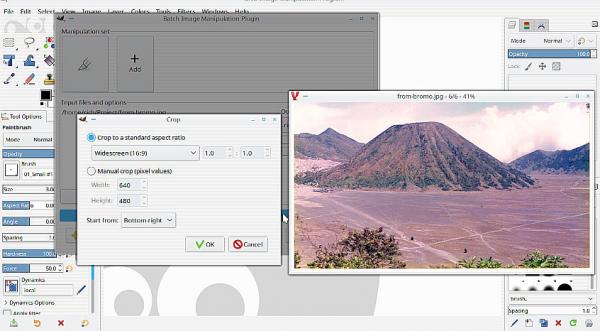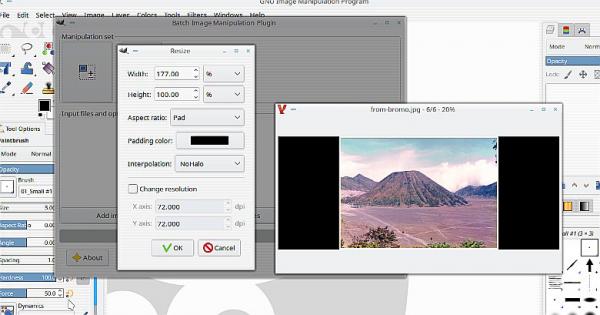Posts: 3
Threads: 2
Joined: Mar 2022
Reputation:
0
Gimp version:
Operating system(s): Windows Vista or 7, 8, 10 (64-bit)
My camera doesn't take 16:9 aspect ratio.
That's the ratio of a standard TV where I view my jpeg pictures.
Therefore, I need to crop them – in bulk.
I also need the Crop Rectangle to be at the bottom of the frame
(not centred across the middle where most crop software places it.
The reason is that generally, the top part of the picture is is less important than lowe down.
So what I would like is a stored template which will do this for me automatically, and in bulk if at all possible.
Does anyone know if this can be done in Gimp?
Posts: 6,949
Threads: 297
Joined: Oct 2016
Reputation:
605
Gimp version:
Operating system(s): Linux
(08-18-2022, 12:00 PM)Gimlet Wrote: My camera doesn't take 16:9 aspect ratio.
That's the ratio of a standard TV where I view my jpeg pictures.
Therefore, I need to crop them – in bulk.
I also need the Crop Rectangle to be at the bottom of the frame
(not centred across the middle where most crop software places it.
The reason is that generally, the top part of the picture is is less important than lowe down.
So what I would like is a stored template which will do this for me automatically, and in bulk if at all possible.
Does anyone know if this can be done in Gimp?
How to script 2.99/3.0 is still in some state of flux, so I would ask in the general forum how to do it with 2.10.
This said this is typically something to do in a shell script with ImageMagick
Posts: 7,849
Threads: 166
Joined: Oct 2016
Reputation:
1,078
Gimp version:
Operating system(s): Linux
@Gimlet Are you really using Gimp 2.99 / 3.0 or are you in the wrong section ?
If you are still using Windows Gimp 2.10 then the BIMP batch plugin crops to 16:9 from a corner
https://alessandrofrancesconi.it/projects/bimp/
Example: with result inset:

As an alternative, in video it is common to keep the frame size and add 'pillars' to pad out to 16:9
another example:

BIMP will also export to interlaced jpeg which is sometimes required for TV / picture frame displays.
Posts: 6,949
Threads: 297
Joined: Oct 2016
Reputation:
605
Gimp version:
Operating system(s): Linux
(08-18-2022, 01:16 PM)rich2005 Wrote: BIMP will also export to interlaced jpeg which is sometimes required for TV / picture frame displays.
I think you mean "non-interlaced" since "interlaced" if Gimp's default, and indeed is not understood by some very ancient JPEG decoders that found their way into frame displays and some "smart" TVs.
Posts: 7,849
Threads: 166
Joined: Oct 2016
Reputation:
1,078
Gimp version:
Operating system(s): Linux
Could be patron (sorry, I have been watching old episodes of Maigret)
My default Gimp 2.10.32 jpeg export is set to progressive (non-interlaced) and BIMP has progressive set off.
Posts: 3
Threads: 2
Joined: Mar 2022
Reputation:
0
Gimp version:
Operating system(s): Windows Vista or 7, 8, 10 (64-bit)
Many thanks rich2005 for your input.
Just what I needed - it works perfectly for me doing the mask bias to the bottom
and processes bulk jpegs.
I notice that there is some loss of defenition, the size reducing from 8820KB to 2845KB,
but I assume that is inevitable.
Posts: 6,949
Threads: 297
Joined: Oct 2016
Reputation:
605
Gimp version:
Operating system(s): Linux
(08-18-2022, 02:15 PM)rich2005 Wrote: Could be patron (sorry, I have been watching old episodes of Maigret)
My default Gimp 2.10.32 jpeg export is set to progressive (non-interlaced) and BIMP has progressive set off.
AFAIK progressive==interlaced?
Posts: 7,849
Threads: 166
Joined: Oct 2016
Reputation:
1,078
Gimp version:
Operating system(s): Linux
From a video perspective
Progressive or non-interlaced scanning is any method for displaying moving images in which the lines of each frame are drawn in sequence. This is in contrast to the interlacing used in traditional television systems.
Interlace, Interlaced, Interlacing, non-progressive
Each frame of a video picture is scanned twice. Firstly, all the odd lines are broadcast, then all the even lines are broadcast.
Posts: 6,949
Threads: 297
Joined: Oct 2016
Reputation:
605
Gimp version:
Operating system(s): Linux
(08-19-2022, 07:33 AM)rich2005 Wrote: From a video perspective
Progressive or non-interlaced scanning is any method for displaying moving images in which the lines of each frame are drawn in sequence. This is in contrast to the interlacing used in traditional television systems.
Interlace, Interlaced, Interlacing, non-progressive
Each frame of a video picture is scanned twice. Firstly, all the odd lines are broadcast, then all the even lines are broadcast.
Yes, but when it comes with still images, interlaced/progressive means that the file data start with lines 1,5,9,13.... and when the bottom line has been reached, continue with 3, 7, 11,... and then 2, 6, 10... and then 4, 8, 12...
So when you have received 1/4 of the data you have a low-res version (one line out of four) of the complete image, and with half the data, you have a better version of the complete image (one line out of two). So with slow internet, your web pages don't come out with big empty spaces while the images are downloaded.
Posts: 7,849
Threads: 166
Joined: Oct 2016
Reputation:
1,078
Gimp version:
Operating system(s): Linux
Yes, I know that and it does tell you in the documentation that jpeg progressive is the same as gif interlaced. Trust the Gimp developers to have a screwed-up definition.
...but tell it to your 720i or 1080p TV when you come to display images.
|



